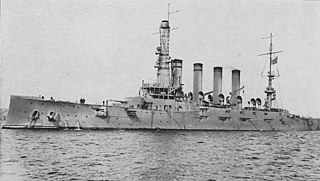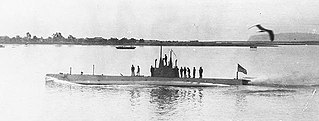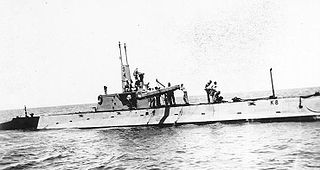
USS Wyoming was the second ship of the United States Navy to bear that name, but the first to bear it in honor of the 44th state. The first Wyoming was named for Wyoming Valley in eastern Pennsylvania.

The second USS Maryland (ACR-8/CA-8), also referred to as "Armored Cruiser No. 8", and later renamed Frederick, was a United States Navy Pennsylvania-class armored cruiser.

USS F-2 (SS-21) was an F-class submarine built for the United States Navy during the 1910s.

USS F-1 (SS-20) was an F-class submarine. She was named Carp when her keel was laid down by Union Iron Works of San Francisco, California, making her the first ship of the United States Navy named for the carp. She was launched on 6 September 1911 sponsored by Ms. J. Tynan, renamed F-1 on 17 November 1911, and commissioned on 19 June 1912.

USS H-1 (SS-28), the lead ship of her class of submarine of the United States Navy, was originally named Seawolf, making her the first ship of the U.S. Navy to be named for the seawolf.

USS S-4 (SS-109) was an S-class submarine of the United States Navy. In 1927, she was sunk by being accidentally rammed by a United States Coast Guard destroyer with the loss of all hands but was raised and restored to service until stricken in 1936.

USS Grampus (SS-4), a Plunger-class submarine later named A-3, was the fourth ship of the United States Navy to be named for a member of the dolphin family, Grampus griseus.

USS G-1 (SS-19½) was the lead ship of her class of submarine of the United States Navy. While the four G-boats were nominally all of a class, they differed enough in significant details that they are sometimes considered to be four unique boats, each in a class by herself.

USS Rainbow (AS-7) was the only ship in the United States Navy by that name. The ship was originally converted to a distilling ship in 1898, and then converted again in 1917 to a submarine tender.

The first USS Pike (SS-6) was a Plunger-class submarine in the service of the United States Navy, later renamed as A-5.

The third USS Preble was a Bainbridge-class destroyer in commission in the United States Navy from 1903 to 1919. She was named for Commodore Edward Preble. She saw service in World War I.

USS L-8 (SS-48) was an L-class submarine built for the United States Navy during the 1910s.

USS K-7 (SS-34) was a K-class submarine built for the United States Navy during the 1910s.

USS K-8 (SS-39) was a K-class submarine of the United States Navy. Her keel was laid down by the Union Iron Works in San Francisco, California, under subcontract from Electric Boat Company of Groton, Connecticut. She was launched on 11 July 1914 sponsored by Mrs. John W. Lewis, wife of the first commanding officer, and commissioned on 1 December at Mare Island.

The third USS Alert was an iron-hulled screw steamer gunboat in the United States Navy. The lead ship in her class, Alert was destined for a long naval career, serving from 1875 to 1922, a period of 47 years, including service as a submarine tender in World War I. Toward the end of her career she received the designation AS-4.

USS Moody (DD-277) was a Clemson-class destroyer in the United States Navy in commission from 1919 to 1922 and from 1923 to 1930. She was named for Justice William Henry Moody.

The first USS Rowan was a torpedo boat in the United States Navy during the Spanish–American War. She was named for Vice Admiral Stephen Rowan.

The first USS Farragut was a torpedo boat in the United States Navy. She was named for David Farragut, commander-in-chief of the U.S. Navy during the American Civil War.

USS Savannah was a submarine tender in the United States Navy in World War I and the years after. She was launched 18 April 1899 as a German commercial freighter SS Saxonia, but was seized by the United States in 1917 and renamed Savannah. In 1933, the ship was renamed USS AS-8 to allow USS Savannah to have the Savannah name.

Naval Base San Pedro and San Pedro Submarine Base were United States Navy bases at the Port of San Pedro, California officially founded in 1919. While commissioned in 1919, the Navy started operating out of the port in 1910, by renting dock space at the City of San Pedro's Dock No. 1 in 1914. The Navy had vessels stationed at the port starting in 1913. The San Pedro Submarine Base closed in 1923, with the end of World War I. Naval Base San Pedro became part of Naval Operating Base Terminal Island on 25 September 1941, which closed in 1947.






















